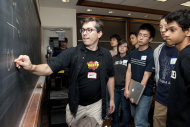All the Children are Above Average
by John Marschhausen • • 12 Comments
“Where all the women are strong, all the men are good looking, and all the children are above average.”
 Those are the closing words Garrison Keillor spoke each night on his radio show A Prairie Home Companion. He was summarizing the fictional hometown Lake Wobegon – a special place. It’s an interesting concept – this idea that “all the children are above average” and, I believe, can be a detrimental one when viewed through the lens of government-mandated testing.
Those are the closing words Garrison Keillor spoke each night on his radio show A Prairie Home Companion. He was summarizing the fictional hometown Lake Wobegon – a special place. It’s an interesting concept – this idea that “all the children are above average” and, I believe, can be a detrimental one when viewed through the lens of government-mandated testing.
From No Child Left Behind to the Third Grade Reading Guarantee, from OTES to PARCC Assessments, these Federal and state mandates share a common theme – all expect our children to be above average, by their standards. Our federal and state policy makers expect all children to perform at a specific level.
It’s a model of educational conformity at its finest. The “ideal” of what each child should be able to achieve.
Here’s my problem – children aren’t widgets.
Lake Wobegon, as wonderful as it sounds, is fictional.
Each child we have the blessing to educate is unique. Each child, as I recently heard from education thought leader and bestselling author Sir Kenneth Robinson, “is a fountain of possibilities.” The young people in our schools can’t be considered to be outputs. As educators we must cultivate the right conditions for learning; we must find each child’s passion, talent, and creativity. As educators we must capitalize on the great diversity in our schools and guide young people to find their talents with an eye toward using these to positively contribute to society.
I am not opposed to accountability or assessments; I believe we should continually assess students on individual progress. I believe data is essential in directing instruction and evaluating performance. Statistical analysis is necessary at a classroom and building level. I also believe that we must take individual differences, developmental differences, and life experiences into account.
There is no – none, zero, zilch – assessment that can accurately assess all children.
There is no one-size-fits-all test, fix, or easy way to measure student academic performance. It is difficult, challenging and messy work. We must abandon the idea that we can fix education with more money, a new program, and a piece of legislation. You can’t legislate learning any more than you can legislate love; learning is organic, it happens when passion meets opportunity, when a great teacher creates an amazing experience for students to embrace.
Let’s commit ourselves to the monumental challenge of making educationpersonal for each child. Let’s tap into the passion, talent, and drive of parents, communities, and our dedicated educators nation-wide and explore every opportunity to motivate each individual student in our care. We must celebrate our diversity – the amazing differences in background, experiences, talents, abilities, and beliefs – and capitalize on opportunities to prepare each student for success after public education. We know we need a diversified workforce to drive our economy. We don’t need every student to be the same; we need every graduate to have skills, passion, and desire to be ready for productive lives as adults.
Our current school structure works very well for a certain segment of our population; it fits their personal learning styles and they flourish in the experiences a traditional school offers. Our current structure is inadequate and antiquated for some students in our education system – we must seek different opportunities to cultivate the personal styles and needs for these students. As Ken Robinson reminds us, “we all started with the miracle of birth and each life is a unique, unprecedented moment in history.”
Each child is gifted in some unique way; each child has a passion, each child is creative, and every student in our schools deserves the opportunity to write his or her own compelling and engaging success story – utilizing a unique voice no government mandate or standardized test could possibly measure.
All of our children are above average . . . just not in the same areas.














 Learn. Teach. Lead.
Learn. Teach. Lead.